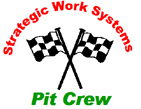What Are Your Top Three Challenges?
We all face challenging situations every day. In many cases, that’s a maintenance organization’s way of life day in and day out. But it’s the long-term challenges—the ones at our doorstep or looming just over the horizon—that may be easy to put off. Those are the giants that are bearing down on us.
Not too long ago, I spoke to nearly 90 maintenance professionals at an Oklahoma Predictive Maintenance User’s Group event. These were maintenance managers and supervisors, technicians and mechanics, planners and engineers from a wide variety of industries. Regardless of their role or their business, they were all pursuing better maintenance practices.
I asked them to take a few minutes and think about the “top three challenges you see for maintenance in the next three to five to 10 years” and write them down on note cards. Let’s consider their challenges, especially those that mirror you own.
Types of Challenges
The respondents listed 117 challenges in nine categories. (Some responses fit in more than one category.)
- Skills gaps (35)
- Culture of reliability (35)
- Training and qualification (27)
- Top management (26)
- New technology (11)
- At-risk assets (10)
- Parts (10)
- Knowledge transfer (8)
- Life-cycle asset management (5)
It’s About People on the Front
Line When we look for a common theme among these responses, it’s not too surprising to see: it’s about people: the biggest variable in improving equipment maintenance, performance, and reliability. With a combined total of 70 responses, three challenges—skills gaps, training and qualification, and knowledge transfer—point to the issues on the front line of maintenance.
Many responses described the difficulty of finding qualified technicians and the shortages of skilled tradespeople. A few spoke of the Millennial generation communication, work habits, and expectations. Several responses addressed the lack of competencies for and interests in industrial maintenance careers.
Capturing the knowledge of the current workers nearing retirement appeared to be a sizable challenge for many, who indicated their organizations stand a chance of losing all the skills and knowledge gained from years of experience. But more than that, there was concern that even if they could capture the knowledge, without a capable replacement or the mechanism to train new employees, the knowledge would be lost.
It’s About People in Top-Level Management
With a combined total of 66, the second grouping—top management, culture of reliability, and life-cycle asset management—points to the leadership needed to improve equipment maintenance, performance, and reliability. Whether it’s the pursuit of best practices, asset management processes, or culture change, top management sets the tone and defines the culture by purposeful actions, or by default through their inaction.
Some of the responses tied top management to the organization’s struggle with hiring and training priorities: their inability to grasp the severity of skills gaps, shortages, and knowledge transfer. Several responses addressed the decisions to cut maintenance costs and staff, reduce time for preventive maintenance, and misinterpreting the reliability requirements of new equipment. Several spoke of silo organizations and decision making that hindered maintenance and hurt the reliability of equipment and processes. These siloed objectives and decisions led to the organization’s inability to focus on common goals—goals for the overall improvement of the business.
A culture of reliability came in tied as the top challenge, ranking alongside skills gaps. Leading a culture of reliability means the line of sight between reliability best practices and the goals of the business are understood. But oftentimes, that line of sight is not so apparent with reliability best practices appearing as nothing more than the technology of the month.
Facing the Giant
Most equipment challenges lend themselves to reliable and sustainable countermeasures or corrective actions. The giant we face isn’t so easily addressed. Human variation, inconsistency, behaviors, moods, and habits present an ever-changing reliability improvement challenge. Sometimes, this giant is among the front-line crews or behind the decisions and actions made by top-level to mid-level to front-line management.
Facing the giant with slings and stones may be our only viable option— if the slings and stones represent the fundamentals, the tools we have, and accepting the reality of the situation. We can no longer manage equipment performance and reliability the way we always have. There are not enough talented people or time or money to continue that journey.
The skills gaps we see today, coupled with the challenges of training and knowledge transfer, are mostly caused by top management and reliability practitioners not seated at the same table and not focusing on common business goals.
Looking to the Future
Facing the giant will require fewer hands-on people, robust condition monitoring, building reliability into the most at risk equipment, and most of all, getting top-level management to believe in reliability best practices.
© 2017 Strategic Work Systems, Inc.
PO Box 70 Columbus, NC 28722
(828) 894-5338
[email protected]
- Download a copy of this document by clicking here: Top Three Challenges
